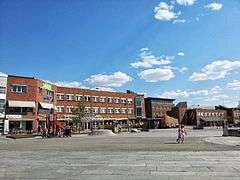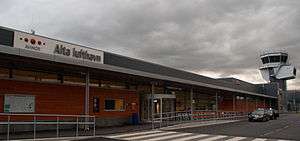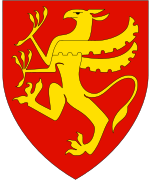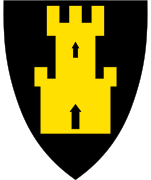Alta, Norway
![]()
Alta kommune | |
|---|---|
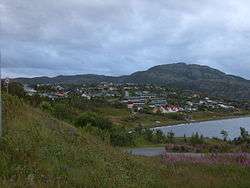 View of housing in Alta | |
 Flag 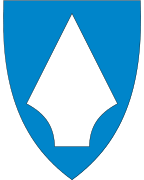 Coat of arms  Troms og Finnmark within Norway | |
 Alta within Troms og Finnmark | |
| Coordinates: 69°58′36″N 23°17′45″E | |
| Country | Norway |
| County | Troms og Finnmark |
| District | Vest-Finnmark |
| Established | 1 Jan 1863 |
| Administrative centre | Alta |
| Government | |
| • Mayor (2015) | Monica Nielsen (Ap) |
| Area | |
| • Total | 3,849.47 km2 (1,486.29 sq mi) |
| • Land | 3,652.76 km2 (1,410.34 sq mi) |
| • Water | 196.71 km2 (75.95 sq mi) 5.1% |
| Area rank | 7 in Norway |
| Population (2020) | |
| • Total | 20,789 ( |
| • Rank | 60 in Norway |
| • Density | 5.7/km2 (15/sq mi) |
| • Change (10 years) | 11.3% |
| Demonym(s) | Altaværing[1] |
| Time zone | UTC+01:00 (CET) |
| • Summer (DST) | UTC+02:00 (CEST) |
| ISO 3166 code | NO-5403 |
| Official language form | Bokmål[2] |
| Website | www |
The 3,849-square-kilometre (1,486 sq mi) municipality is the 7th largest municipality by area out of the 356 municipalities in Norway. Alta is the 60th most populous municipality in Norway with a population of 20,789. The municipality's population density is 5.7 inhabitants per square kilometre (15/sq mi) and its population has increased by 11.3% over the last decade.[4][5]
General information
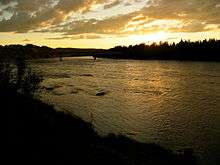
The municipality of Alten-Talvig was established on 1 January 1838 (see formannskapsdistrikt). On 1 January 1863, the municipality was divided into two: Talvik to the north (population: 1,938) and Alta to the south (population: 2,442). On 1 January 1964, the two municipalities were merged back together to form the new, larger municipality of Alta. Prior to the merger, Alta had 6,629 residents and Talvik had 3,266 residents. The borders have not changed since that time.[6]
On 1 January 2020, the municipality became part of the newly formed Troms og Finnmark county. Previously, it had been part of the old Finnmark county.[7]
Name
The municipality is probably named after the local Altafjorden. The name possibly comes from the Old Norse (ǫlpt or alpt) which refers to a swan or it is a Norwegianization of the Finnish word (alaattia) which refers to a "lowland". Prior to 1918, the name was written Alten.[8][9]
Coat of arms
The coat of arms is from modern times; they were granted on 9 July 1976. The arms show a white arrow point on a blue background. The arrow is derived from the findings of quartzite arrow points dating back to the late Stone Age and found in the area. The quartzite was quarried in the municipality and tools made from it were used all over Northern Norway.[10]
Churches
The Church of Norway has two parishes (sokn) within the municipality of Alta. It is part of the Alta prosti (deanery) in the Diocese of Nord-Hålogaland.
| Parish (Sokn) | Church Name | Location of the Church | Year Built |
|---|---|---|---|
| Alta | Alta Church | Alta | 1858 |
| Elvebakken Church | Alta | 1964 | |
| Kåfjord Church | Kåfjord | 1837 | |
| Northern Lights Cathedral | Alta | 2013 | |
| Rafsbotn Chapel | Rafsbotn | 1989 | |
| Talvik | Komagfjord Church | Komagfjord | 1960 |
| Langfjord Church | Langfjordbotn | 1891 | |
| Leirbotn Church | Leirbotn | 1993 | |
| Talvik Church | Talvik | 1883 |
History
The rock carvings at Alta, located near the Jiepmaluokta bay, dating from c. 4200 BC to 500 BC, are on the UNESCO list of World Heritage Sites. The Komsa culture was named after the Komsa mountain in Alta municipality, where the first archeological remains of this culture were discovered.
In the aftermath of the Sami Kautokeino rebellion of 1852, rebel leaders Mons Aslaksen Somby and Aslak Jacobsen Hætta were decapitated at Elvebakken in what is now the town of Alta on 14 October 1854.
Their bodies were buried in graves just outside the Kåfjord Church graveyard in the village of Kåfjord in Alta, but their heads were sent on to the Anatomisk Institute at the Kong Medical Frederiks University in Oslo, where they were kept for more than a century as part of the university's skull collections. The two skulls were only relinquished by the university in 1985, following a controversy and protests by Sami activists, and were in November 1997 buried at the Kåfjord Church in Alta, at the same spot as their bodies were buried over 140 years earlier.
During World War II, the German battleship Tirpitz used the Kåfjorden, an arm of Altafjorden, as a harbour, and was damaged here by attacking Allied warplanes. The town Alta was seriously destroyed by fire near the end of the World War II. It was rebuilt in subsequent years.
The Altasaken in 1979 made headlines for weeks, as many people (especially Sami people and environmentalists) demonstrated and used civil disobedience to prevent the building of a dam on the river Altaelva in order to produce hydropower. The dam was built, however, and the river still offers good salmon fishing. The King of Norway usually visits the river once in the summer to fish.
The urban area made up of Bossekop, Elvebakken, and Bukta, also known collectively now as the town of Alta, became a town on 1 January 2000. The population has been growing steadily for many years.
Government
All municipalities in Norway, including Alta, are responsible for primary education (through 10th grade), outpatient health services, senior citizen services, unemployment and other social services, zoning, economic development, and municipal roads. The municipality is governed by a municipal council of elected representatives, which in turn elect a mayor.[11] The municipality falls under the Alta District Court and the Hålogaland Court of Appeal.
Municipal council
The municipal council (Kommunestyre) of Alta is made up of 35 representatives that are elected to four year terms. The party breakdown of the council is as follows:
| Party Name (in Norwegian) | Number of representatives | |
|---|---|---|
| Labour Party (Arbeiderpartiet) | 9 | |
| Progress Party (Fremskrittspartiet) | 7 | |
| Green Party (Miljøpartiet De Grønne) | 1 | |
| Conservative Party (Høyre) | 3 | |
| Christian Democratic Party (Kristelig Folkeparti) | 1 | |
| Red Party (Rødt) | 2 | |
| Centre Party (Senterpartiet) | 5 | |
| Socialist Left Party (Sosialistisk Venstreparti) | 4 | |
| Liberal Party (Venstre) | 3 | |
| Total number of members: | 35 | |
| Party Name (in Norwegian) | Number of representatives | |
|---|---|---|
| Labour Party (Arbeiderpartiet) | 11 | |
| Progress Party (Fremskrittspartiet) | 7 | |
| Green Party (Miljøpartiet De Grønne) | 1 | |
| Conservative Party (Høyre) | 4 | |
| Christian Democratic Party (Kristelig Folkeparti) | 2 | |
| Coastal Party (Kystpartiet) | 2 | |
| Centre Party (Senterpartiet) | 1 | |
| Socialist Left Party (Sosialistisk Venstreparti) | 3 | |
| Liberal Party (Venstre) | 4 | |
| Total number of members: | 35 | |
| Party Name (in Norwegian) | Number of representatives | |
|---|---|---|
| Labour Party (Arbeiderpartiet) | 10 | |
| Progress Party (Fremskrittspartiet) | 4 | |
| Conservative Party (Høyre) | 10 | |
| Christian Democratic Party (Kristelig Folkeparti) | 1 | |
| Coastal Party (Kystpartiet) | 4 | |
| Socialist Left Party (Sosialistisk Venstreparti) | 3 | |
| Liberal Party (Venstre) | 3 | |
| Total number of members: | 35 | |
| Party Name (in Norwegian) | Number of representatives | |
|---|---|---|
| Labour Party (Arbeiderpartiet) | 15 | |
| Progress Party (Fremskrittspartiet) | 8 | |
| Conservative Party (Høyre) | 2 | |
| Christian Democratic Party (Kristelig Folkeparti) | 2 | |
| Coastal Party (Kystpartiet) | 1 | |
| Centre Party (Senterpartiet) | 1 | |
| Socialist Left Party (Sosialistisk Venstreparti) | 4 | |
| Liberal Party (Venstre) | 2 | |
| Total number of members: | 35 | |
| Party Name (in Norwegian) | Number of representatives | |
|---|---|---|
| Labour Party (Arbeiderpartiet) | 14 | |
| Progress Party (Fremskrittspartiet) | 5 | |
| Conservative Party (Høyre) | 3 | |
| Christian Democratic Party (Kristelig Folkeparti) | 2 | |
| Coastal Party (Kystpartiet) | 1 | |
| Red Electoral Alliance (Rød Valgallianse) | 1 | |
| Centre Party (Senterpartiet) | 2 | |
| Socialist Left Party (Sosialistisk Venstreparti) | 6 | |
| Liberal Party (Venstre) | 1 | |
| Total number of members: | 35 | |
| Party Name (in Norwegian) | Number of representatives | |
|---|---|---|
| Labour Party (Arbeiderpartiet) | 13 | |
| Progress Party (Fremskrittspartiet) | 4 | |
| Conservative Party (Høyre) | 5 | |
| Christian Democratic Party (Kristelig Folkeparti) | 3 | |
| Centre Party (Senterpartiet) | 1 | |
| Socialist Left Party (Sosialistisk Venstreparti) | 4 | |
| Liberal Party (Venstre) | 2 | |
| Joint list of the Red Electoral Alliance (Rød Valgallianse) and the Communist Party (Kommunistiske Parti) | 1 | |
| Local Democratic List (Lokaldemokratisk liste) | 2 | |
| Total number of members: | 35 | |
| Party Name (in Norwegian) | Number of representatives | |
|---|---|---|
| Labour Party (Arbeiderpartiet) | 19 | |
| Conservative Party (Høyre) | 5 | |
| Christian Democratic Party (Kristelig Folkeparti) | 5 | |
| Red Electoral Alliance (Rød Valgallianse) | 3 | |
| Centre Party (Senterpartiet) | 4 | |
| Socialist Left Party (Sosialistisk Venstreparti) | 6 | |
| Liberal Party (Venstre) | 3 | |
| Total number of members: | 45 | |
| Party Name (in Norwegian) | Number of representatives | |
|---|---|---|
| Labour Party (Arbeiderpartiet) | 18 | |
| Conservative Party (Høyre) | 7 | |
| Christian Democratic Party (Kristelig Folkeparti) | 3 | |
| Red Electoral Alliance (Rød Valgallianse) | 2 | |
| Centre Party (Senterpartiet) | 4 | |
| Socialist Left Party (Sosialistisk Venstreparti) | 8 | |
| Liberal Party (Venstre) | 3 | |
| Total number of members: | 45 | |
| Party Name (in Norwegian) | Number of representatives | |
|---|---|---|
| Labour Party (Arbeiderpartiet) | 26 | |
| Progress Party (Fremskrittspartiet) | 2 | |
| Conservative Party (Høyre) | 5 | |
| Communist Party (Kommunistiske Parti) | 1 | |
| Christian Democratic Party (Kristelig Folkeparti) | 3 | |
| Red Electoral Alliance (Rød Valgallianse) | 1 | |
| Centre Party (Senterpartiet) | 1 | |
| Socialist Left Party (Sosialistisk Venstreparti) | 3 | |
| Liberal Party (Venstre) | 3 | |
| Total number of members: | 45 | |
| Party Name (in Norwegian) | Number of representatives | |
|---|---|---|
| Labour Party (Arbeiderpartiet) | 21 | |
| Progress Party (Fremskrittspartiet) | 1 | |
| Conservative Party (Høyre) | 8 | |
| Communist Party (Kommunistiske Parti) | 2 | |
| Christian Democratic Party (Kristelig Folkeparti) | 4 | |
| Centre Party (Senterpartiet) | 1 | |
| Socialist Left Party (Sosialistisk Venstreparti) | 3 | |
| Liberal Party (Venstre) | 4 | |
| Local list for Western Alta (Kretsliste for Vestre Alta) | 1 | |
| Total number of members: | 45 | |
| Party Name (in Norwegian) | Number of representatives | |
|---|---|---|
| Labour Party (Arbeiderpartiet) | 16 | |
| Conservative Party (Høyre) | 9 | |
| Communist Party (Kommunistiske Parti) | 3 | |
| Christian Democratic Party (Kristelig Folkeparti) | 5 | |
| Centre Party (Senterpartiet) | 2 | |
| Socialist Left Party (Sosialistisk Venstreparti) | 3 | |
| Liberal Party (Venstre) | 7 | |
| Total number of members: | 45 | |
| Party Name (in Norwegian) | Number of representatives | |
|---|---|---|
| Labour Party (Arbeiderpartiet) | 18 | |
| Conservative Party (Høyre) | 5 | |
| Christian Democratic Party (Kristelig Folkeparti) | 6 | |
| Centre Party (Senterpartiet) | 4 | |
| Socialist Left Party (Sosialistisk Venstreparti) | 8 | |
| Liberal Party (Venstre) | 4 | |
| Total number of members: | 45 | |
| Party Name (in Norwegian) | Number of representatives | |
|---|---|---|
| Labour Party (Arbeiderpartiet) | 19 | |
| Conservative Party (Høyre) | 4 | |
| Christian Democratic Party (Kristelig Folkeparti) | 4 | |
| Centre Party (Senterpartiet) | 2 | |
| Liberal Party (Venstre) | 3 | |
| Local List(s) (Lokale lister) | 3 | |
| Socialist common list (Venstresosialistiske felleslister) | 10 | |
| Total number of members: | 45 | |
| Party Name (in Norwegian) | Number of representatives | |
|---|---|---|
| Labour Party (Arbeiderpartiet) | 24 | |
| Conservative Party (Høyre) | 4 | |
| Communist Party (Kommunistiske Parti) | 6 | |
| Christian Democratic Party (Kristelig Folkeparti) | 3 | |
| Centre Party (Senterpartiet) | 2 | |
| Socialist People's Party (Sosialistisk Folkeparti) | 3 | |
| Liberal Party (Venstre) | 3 | |
| Total number of members: | 45 | |
| Party Name (in Norwegian) | Number of representatives | |
|---|---|---|
| Labour Party (Arbeiderpartiet) | 24 | |
| Conservative Party (Høyre) | 6 | |
| Communist Party (Kommunistiske Parti) | 8 | |
| Christian Democratic Party (Kristelig Folkeparti) | 4 | |
| Liberal Party (Venstre) | 3 | |
| Total number of members: | 45 | |
| Party Name (in Norwegian) | Number of representatives | |
|---|---|---|
| Labour Party (Arbeiderpartiet) | 14 | |
| Conservative Party (Høyre) | 3 | |
| Communist Party (Kommunistiske Parti) | 11 | |
| Liberal Party (Venstre) | 3 | |
| Total number of members: | 31 | |
| Party Name (in Norwegian) | Number of representatives | |
|---|---|---|
| Labour Party (Arbeiderpartiet) | 14 | |
| Conservative Party (Høyre) | 4 | |
| Communist Party (Kommunistiske Parti) | 10 | |
| Liberal Party (Venstre) | 3 | |
| Total number of members: | 31 | |
| Party Name (in Norwegian) | Number of representatives | |
|---|---|---|
| Labour Party (Arbeiderpartiet) | 8 | |
| Communist Party (Kommunistiske Parti) | 8 | |
| Joint List(s) of Non-Socialist Parties (Borgerlige Felleslister) | 4 | |
| Total number of members: | 20 | |
| Party Name (in Norwegian) | Number of representatives | |
|---|---|---|
| Labour Party (Arbeiderpartiet) | 7 | |
| Communist Party (Kommunistiske Parti) | 8 | |
| Christian Democratic Party (Kristelig Folkeparti) | 1 | |
| Joint List(s) of Non-Socialist Parties (Borgerlige Felleslister) | 4 | |
| Total number of members: | 20 | |
| Party Name (in Norwegian) | Number of representatives | |
|---|---|---|
| Labour Party (Arbeiderpartiet) | 6 | |
| Communist Party (Kommunistiske Parti) | 11 | |
| Local List(s) (Lokale lister) | 3 | |
| Total number of members: | 20 | |
| Party Name (in Norwegian) | Number of representatives | |
|---|---|---|
| Labour Party (Arbeiderpartiet) | 6 | |
| Communist Party (Kommunistiske Parti) | 6 | |
| Liberal Party (Venstre) | 3 | |
| Joint list of the Conservative Party (Høyre) and the Free-minded People's Party (Frisinnede Folkeparti) | 4 | |
| List of workers, fishermen, and small farmholders (Arbeidere, fiskere, småbrukere liste) | 1 | |
| Total number of members: | 20 | |
Geography
Alta is the second northernmost city in the world surpassing 10,000 inhabitants. Alta municipality covers 3,845 square kilometres (1,485 square miles), in the west of the county, mostly situated along the Altafjord, taking in large tracts of woodlands, as well as parts of the High Plateau of Finnmarksvidda. On its way from the plateau down to the fjord, the river Altaelva has carved out the Sautso canyon, one of the largest canyons in Europe. The large Altafjorden has several notable bays and fjord arms that branch off from it including Langfjorden, Jiepmaluokta, Kåfjorden, and Lille Kufjorden.
Alta is based on the mainland of Norway, but it also includes parts of the islands of Stjernøya and Seiland. Seiland is the home of Seiland National Park where the Seilandsjøkelen glacier and the mountain Seilandstuva are located.
Several of the notable lakes in Alta include Iešjávri, Juovvajávri, Kovvatnet, and Stuorajávri.
Climate
Most people live in the town of Alta, stretching along the inner part of the fjord, enjoying a sheltered subarctic climate (Dfc), where daily mean temperatures are above 10 degrees Celsius for only 3 months of the year. Daytime mid-summer temperatures are often comparable to southern parts of Norway, and lowland areas in Alta are mostly sheltered from the winter storms. The mean annual temperature is 1.3 °C (34.3 °F) (1961–90) and the Alta valley does not have permafrost but is dominated by closed-canopy forest of birch and pine. Precipitation is low, with a yearly average precipitation of only 420 millimetres (16.5 in).[30] The frequent clear skies are the reason why Alta early was chosen as an excellent location for studying the aurora borealis. The "midnight sun" is above the horizon from 18 May to 27 July, lasting a bit longer than the polar night from 26 November to 16 January.
| Climate data for Alta, Finnmark (1981–2010, extremes 1874-present) | |||||||||||||
|---|---|---|---|---|---|---|---|---|---|---|---|---|---|
| Month | Jan | Feb | Mar | Apr | May | Jun | Jul | Aug | Sep | Oct | Nov | Dec | Year |
| Record high °C (°F) | 9.9 (49.8) |
11.5 (52.7) |
10.5 (50.9) |
15.6 (60.1) |
25.2 (77.4) |
30.8 (87.4) |
33.0 (91.4) |
31.8 (89.2) |
24.0 (75.2) |
17.4 (63.3) |
12.1 (53.8) |
10.8 (51.4) |
33.0 (91.4) |
| Average high °C (°F) | −3.7 (25.3) |
−3.6 (25.5) |
−0.9 (30.4) |
3.3 (37.9) |
8.2 (46.8) |
13.6 (56.5) |
17.3 (63.1) |
15.7 (60.3) |
10.8 (51.4) |
4.8 (40.6) |
−0.4 (31.3) |
−2.6 (27.3) |
5.2 (41.4) |
| Daily mean °C (°F) | −7.3 (18.9) |
−7.1 (19.2) |
−4.4 (24.1) |
0.0 (32.0) |
5.1 (41.2) |
10.4 (50.7) |
14.0 (57.2) |
12.5 (54.5) |
7.9 (46.2) |
2.3 (36.1) |
−3.4 (25.9) |
−6.0 (21.2) |
2.1 (35.8) |
| Average low °C (°F) | −10.9 (12.4) |
−10.6 (12.9) |
−7.8 (18.0) |
−3.2 (26.2) |
2.1 (35.8) |
7.2 (45.0) |
10.7 (51.3) |
9.2 (48.6) |
4.9 (40.8) |
−0.2 (31.6) |
−6.4 (20.5) |
−9.4 (15.1) |
−1.2 (29.8) |
| Record low °C (°F) | −34.0 (−29.2) |
−30.5 (−22.9) |
−28.5 (−19.3) |
−21.7 (−7.1) |
−16.4 (2.5) |
−3.8 (25.2) |
0.2 (32.4) |
−2.1 (28.2) |
−8.5 (16.7) |
−20.4 (−4.7) |
−33.0 (−27.4) |
−31.3 (−24.3) |
−34.0 (−29.2) |
| Average precipitation mm (inches) | 38.7 (1.52) |
28.0 (1.10) |
22.7 (0.89) |
22.0 (0.87) |
24.2 (0.95) |
32.1 (1.26) |
49.7 (1.96) |
43.7 (1.72) |
36.1 (1.42) |
42.4 (1.67) |
33.0 (1.30) |
41.9 (1.65) |
413.9 (16.30) |
| Average precipitation days | 9.6 | 7.7 | 6.5 | 6.4 | 5.8 | 6.3 | 8.3 | 8.0 | 8.5 | 9.6 | 8.4 | 10.1 | 95.2 |
| Source: [31][32] | |||||||||||||
Transportation
Alta is a transportation center in Finnmark. Alta Airport served 334,132 passengers in 2009. There are direct flights to Oslo, Tromsø, Vadsø, and Kirkenes. The town of Alta also has port facilities in the town center, and European route E6 passes through Alta. The distance to southern Scandinavia is considerably shorter over European route E45 and northern Finland.
Economy
Main activities in Alta include trading, small industry, education, and public service. The town is also famous for its slate industry. Finnmark University College (Norwegian: Høgskolen i Finnmark) is situated in Alta, and there is also a research institution (Norut NIBR Finnmark). The town has the northernmost ice hotel in Europe.
Sports
Alta is home to the football club Alta IF. Cross-country skiing is very popular. Alta also has clubs for handball, track and field, alpine skiing, ice skating, taekwondo, and judo.
The bicycle race Finnmark Offroad, with 700- and 300-kilometer long courses, starts and ends in Alta (as of 2014).[33]
Alta is the starting point for the Finnmarksløpet, a 500- and 1000- kilometer sled dog race—The longest sled dog race in Europe.[34]
Notable residents
- Klaus Pettersen, Norwegian football coach
- Egil Rasmussen, author (1903–1964)
- Bjørn Wirkola, Norwegian ski jumper
- Finn Hågen Krogh, Norwegian cross-country skier
- Tommy Wirkola, Norwegian filmmaker
- Karl Akre, Norwegian educator and politician
- Martin Moland, Norwegian Snocross racer
International relations
See also
- Alta Museum
References
- "Navn på steder og personer: Innbyggjarnamn" (in Norwegian). Språkrådet.
- "Forskrift om målvedtak i kommunar og fylkeskommunar" (in Norwegian). Lovdata.no.
- Formerly, Álaheadju was used as the Northern Sámi name. This reflects the dialect of the Inland Sámi, while Áltá is the name in the original Sámi dialect of the area.
- Statistisk sentralbyrå (2020). "Table: 06913: Population 1 January and population changes during the calendar year (M)" (in Norwegian).
- Statistisk sentralbyrå. "09280: Area of land and fresh water (km²) (M)" (in Norwegian).
- Jukvam, Dag (1999). "Historisk oversikt over endringer i kommune- og fylkesinndelingen" (PDF) (in Norwegian). Statistisk sentralbyrå.
- Mæhlum, Lars, ed. (2019-12-24). "Troms og Finnmark". Store norske leksikon (in Norwegian). Kunnskapsforlaget. Retrieved 2019-12-26.
- Rygh, Oluf (1924). Norske gaardnavne: Finmarkens amt (in Norwegian) (18 ed.). Kristiania, Norge: W. C. Fabritius & sønners bogtrikkeri. pp. 11–12.
- Store norske leksikon. "Alta" (in Norwegian). Retrieved 2013-01-24.
- "Civic heraldry of Norway - Norske Kommunevåpen". Heraldry of the World. Retrieved 2018-06-05.
- Hansen, Tore, ed. (2016-05-12). "kommunestyre". Store norske leksikon (in Norwegian). Kunnskapsforlaget. Retrieved 2018-06-05.
- "Tall for Norge: Kommunestyrevalg 2019 - Troms og Finnmark". Valg Direktoratet. Retrieved 2019-10-21.
- "Table: 04813: Members of the local councils, by party/electoral list at the Municipal Council election (M)" (in Norwegian). Statistics Norway.
- "Tall for Norge: Kommunestyrevalg 2011 - Finnmark". Valg Direktoratet. Retrieved 2019-10-21.
- "Kommunestyrevalget 1995" (PDF) (in Norwegian). Oslo-Kongsvinger: Statistisk sentralbyrå. 1996. Retrieved 2020-03-18.
- "Kommunestyrevalget 1991" (PDF) (in Norwegian). Oslo-Kongsvinger: Statistisk sentralbyrå. 1993. Retrieved 2020-03-18.
- "Kommunestyrevalget 1987" (PDF) (in Norwegian). Oslo-Kongsvinger: Statistisk sentralbyrå. 1988. Retrieved 2020-03-18.
- "Kommunestyrevalget 1983" (PDF) (in Norwegian). Oslo-Kongsvinger: Statistisk sentralbyrå. 1984. Retrieved 2020-03-18.
- "Kommunestyrevalget 1979" (PDF) (in Norwegian). Oslo: Statistisk sentralbyrå. 1979. Retrieved 2020-03-18.
- "Kommunevalgene 1975" (PDF) (in Norwegian). Oslo: Statistisk sentralbyrå. 1977. Retrieved 2020-03-18.
- "Kommunevalgene 1972" (PDF) (in Norwegian). Oslo: Statistisk sentralbyrå. 1973. Retrieved 2020-03-18.
- "Kommunevalgene 1967" (PDF) (in Norwegian). Oslo: Statistisk sentralbyrå. 1967. Retrieved 2020-03-18.
- "Kommunevalgene 1963" (PDF) (in Norwegian). Oslo: Statistisk sentralbyrå. 1964. Retrieved 2020-03-18.
- "Kommunevalgene og Ordførervalgene 1959" (PDF) (in Norwegian). Oslo: Statistisk sentralbyrå. 1960. Retrieved 2020-03-18.
- "Kommunevalgene og Ordførervalgene 1955" (PDF) (in Norwegian). Oslo: Statistisk sentralbyrå. 1957. Retrieved 2020-03-18.
- "Kommunevalgene og Ordførervalgene 1951" (PDF) (in Norwegian). Oslo: Statistisk sentralbyrå. 1952. Retrieved 2020-03-18.
- "Kommunevalgene og Ordførervalgene 1947" (PDF) (in Norwegian). Oslo: Statistisk sentralbyrå. 1948. Retrieved 2020-03-18.
- "Kommunevalgene og Ordførervalgene 1945" (PDF) (in Norwegian). Oslo: Statistisk sentralbyrå. 1947. Retrieved 2020-03-18.
- "Kommunevalgene og Ordførervalgene 1937" (PDF) (in Norwegian). Oslo: Statistisk sentralbyrå. 1938. Retrieved 2020-03-18.
- Alta climate statistics Archived 2012-07-14 at Archive.today
- "Norwegian Meteorological Institute". Norwegian Meteorological Institute. Archived from the original on 14 June 2004. Retrieved 7 May 2014.
- "Climate normals for Norway 1981-2010" (in French). Météo Climat. Retrieved 1 February 2019.
- Nå venter 700 kilometer på sykkelsetet i villmarka
- "Finnmarksløpet - Europas longest dog-sled race - 1200km of extreme". www.finnmarkslopet.no (in Norwegian Bokmål). Retrieved 2018-11-06.
- "Vennskapsbyer" (in Norwegian). Alta kommune.
- "Ystävyyskaupungit (Twin Cities)". Oulun kaupunki (City of Oulu) (in Finnish). Retrieved 2013-07-27.
External links
| Wikimedia Commons has media related to Alta, Norway. |
| Wikivoyage has a travel guide for Alta. |
- Alta Tourist Information
- Unesco information
- Høgskolen i Finnmark (Finnmark University College)
- Alta kommune (in Norwegian)
- Alta Igloo Hotel
- Finnmarksløpet-the northernmost sled dog race in the world!
- Avinor:Alta Airport
- Pictures from Alta
- Øytun folk high school, Alta. Outdoor life
